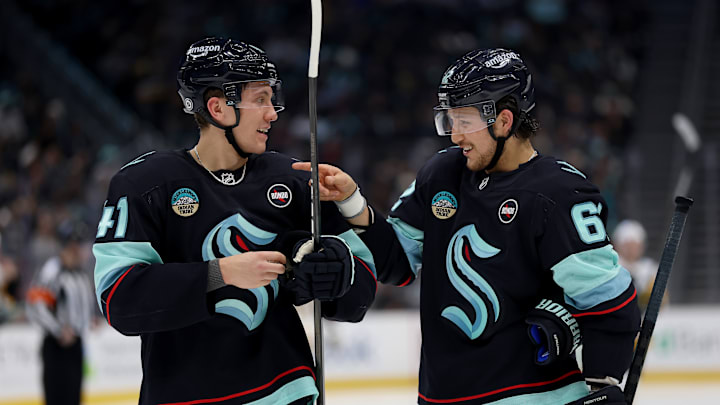In case you missed our earlier deep-dive on Team USA’s selections—where Kraken standouts Matty Beniers and Joey Daccord earned their Stars-and-Stripes call-ups—there’s now a sequel brewing north of the border. Hockey Canada’s initial list for the 2025 IIHF World Championship features Brandon Montour and Ryker Evans, setting up a Kraken-on-Kraken showdown when the North American rivals meet in group play.
Meet the first 1⃣5⃣ players who will wear the 🍁 at #MensWorlds!
— Hockey Canada (@HockeyCanada) May 1, 2025
Voici un premier groupe de 1⃣5⃣ joueurs qui porteront la 🍁 au #MondialMasculin!
ROSTER: https://t.co/MFsEq2UcU5
FORMATION : https://t.co/heJziXAoqx pic.twitter.com/crwW9ky5LH
Seattle’s top pairing of Vince Dunn–Adam Larsson is carved in granite, but the second duo has been a revolving door. Montour—inked last summer to a long-term deal—spent most of the season beside Jamie Oleksiak, a solid but stay-at-home partner. The front office would rather align Montour’s right-handed, high-tempo game with the 23-year-old Evans, whose skating and puck retrieval project as top-four calibre upside. The two saw spot duty late in the year after Seattle was eliminated; giving them extended, pressure-free minutes together on international ice is the ideal chemistry lab.
Montour’s star power meets Evans’ potential
Montour just authored a franchise-record 18-goal season, highlighted by the fastest overtime winner in NHL history—four seconds into the extra frame against Montréal. He also logged the Kraken’s first defenseman hat trick and finished with 41 points, showing exactly why GM Ron Francis opened the checkbook.
Evans, the 35th pick in Seattle’s inaugural 2021 draft, answered the call when Dunn was injured, eating nearly 20 minutes a night and finishing with 25 points in 73 games. His sophmore learning curve was steep—his -12 plus/minus mirrors the team’s broader defensive leaks—but the skill flashes are undeniable: crisp exits, head-up zone entries, and a sneaky one-timer that could pop on the bigger IIHF ice.
When Montour and Evans skated together they logged just over 500 minutes—Evans’ most-used partnership—but controlled fewer than 40 percent of goals. By contrast, Montour spent more than 800 minutes beside Jamie Oleksiak, leaving the Evans experiment very much a work in progress. A fortnight of IIHF action should help the pair iron out their timing and communication before training camp.
What to watch in Sweden and Denmark
- Match-ups: Canada’s defence group also features Noah Dobson, MacKenzie Weegar and Travis Sanheim. Expect coach André Tourigny to cycle partners early; Montour–Evans could start sheltered minutes against non-contenders before seeing tougher match-ups if the chemistry clicks.
- Special teams reps: Montour seems like a lock for the first-unit power play, and Evans’ left shot makes him a natural option to feed Montour’s one-timer from the weak side. If Evans can prove he belongs on a PP2 quarterback role, it translates directly to Kraken usage next fall.
- Bigger ice benefits: The Olympic-sized surface in Herning forces quicker decisions through the neutral zone—an area where Evans shines but where Montour sometimes forces low-percentage carries. Extra space should accentuate Evans’ retrieval-and-rim game and give Montour more clean looks in motion.
- Olympic stakes: With the 2026 Milano-Cortina Games looming, strong performances could cement both players as contenders for the full Canadian roster next winter—adding a layer of motivation beyond off-season development.
The Takeaway
For Kraken fans, the IIHF World Championship are suddenly must-watch TV. A gold medal would be sweet, but the bigger prize is experiential: every extra shift Montour and Evans share in red and white should pay dividends when they slip back into deep sea blue in October. If the duo returns home looking like a ready-made second pair, Seattle’s path back to the playoffs gets a whole lot clearer.
